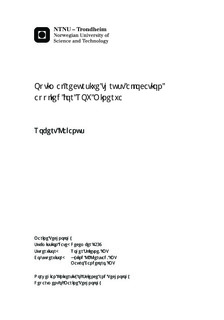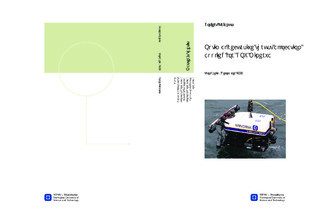| dc.description.abstract | This master thesis considers the thrust allocation problem of the Remotely Operated Vehicle Minerva, operated by the NTNU Applied Underwater Robotics Laboratory. The Minerva is reported to have some issues with the yaw capability when subject to current. Thus, motivating the testing of thrust allocation algorithms prioritizing yaw capability.
To get familiarized with the Minerva, and the Minerva control and simulation systems, the dynamical model of Minerva is presented. In order to present the dynamical model, relevant background information is given. Then, the dynamical behavior and limitations of the Minerva are discussed. Further, the thruster configuration, and current thrust allocation scheme is presented.
Three constrained thrust allocation algorithms are proposed; Recursive nullspace-based thrust allocation, optimal thrust allocation, and optimal recursive thrust allocation. The optimal recursive thrust allocation are the combination of the first two proposed algorithms. The recursive algorithms are motivated by the desire to ensure enough thruster capacity is available to produce the required yaw moment. After satisfying the yaw allocation, the remaining thrust capacity can be utilized to allocate the degrees of freedom in subsequent steps The algorithms are then tested in both open-loop, and closed-loop condition, to ensure functionality.
A simulation case study to test the effectiveness, and compare the performance of the three proposed thrust allocation algorithms were carried out. From open-loop tests it was found that the thruster weighting matrix of the 2$^{nd}$ step of the recursive 3-step nullspace-based thrust allocation algorithm, are of great importance for the overall performance of the algorithm when applied for the Minerva. Leaving the 2$^{nd}$ step thruster weighting matrix as the identity matrix, caused the recursive 3-step algorithm to perform poorer than the pseudoinverse thrust allocation. From closed-loop tests, the proposed implementation of the optimal recursive thrust allocation algorithm is seen to be flawed. The optimal recursive algorithm allocated the thrusters such that the rotational direction of the thrusters were constantly changed back and forth, inducing instability in an otherwise stable system. Such utilization will drastically increase wear and tear of the thrusters. Further, it was found from testing that the optimal thrust allocation algorithm could achieve yaw priority by means of modifying the slack variables. By making the cost on the slack variable corresponding to yaw higher, in order 1000 times higher, than the other slack variables, yaw priority are achieved.
Finally, concluding remarks are given; The proposed optimal recursive thrust allocation algorithm as implemented for the Minerva is seen to be flawed. Therefor there is no point in HIL-testing of the algorithm, as proposed in this thesis. Lastly, recommendations for further work are presented. | |

